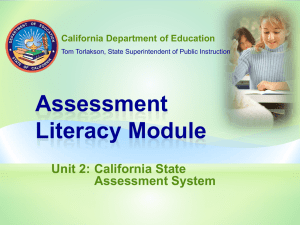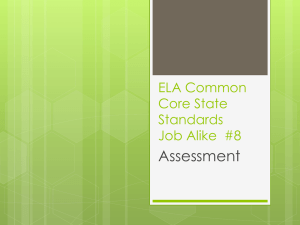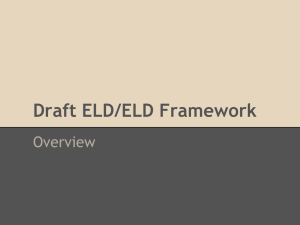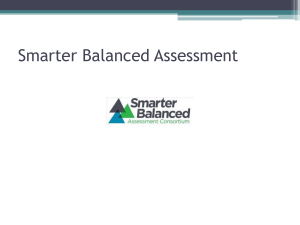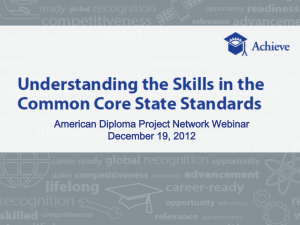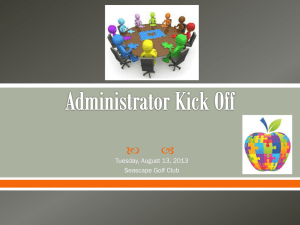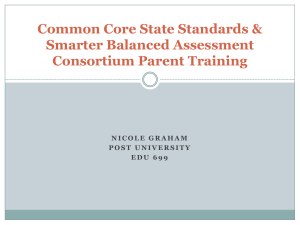short version California Common Core Presentation for BLTs 12-13-13
advertisement
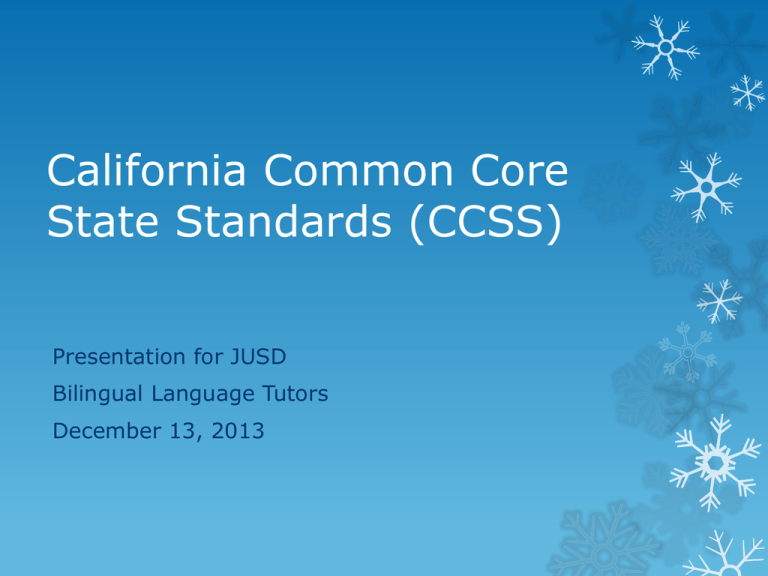
California Common Core State Standards (CCSS) Presentation for JUSD Bilingual Language Tutors December 13, 2013 CCSS Presentation Objectives Today’s Topics: • An Overview of CCSS • The Six Shifts in ELA and Math • Details of the ELA and Math Standards • Timelines for ELA, ELD, Math, and Science • Assessment Changes Education Acronyms Alphabet Soup – 2013/2014 These are terms you may hear out on the street… Video Why do we need Common Core Standards? Grab some paper! Make two columns: Similarities to the 1997 standards and instructional practices Differences from the 1997 standards and instructional practices The Common Core Standards (CCSS) were developed by the Council of Chief State School Officers and the National Governor’s Association Center for Best Practices, and were formally released on June 2, 2010. 6 © 2011 California County Superintendents Educational Services Association The focus of the CCSS is to guarantee that all students are college and career ready as they exit from high school. 7 © 2011 California County Superintendents Educational Services Association Overarching Goals for K-12 CCSS Ensure that our students are: Meeting college and work expectations Prepared to succeed in our global economy and society, and 8 Provided with rigorous content and applications of higher knowledge through higher order thinking skills. © 2011 California County Superintendents Educational Services Association The CCSS build upon the strengths and lessons of current state standards. 9 © 2011 California County Superintendents Educational Services Association What are the benefits of the CCSS? Internationally benchmarked Student expectations are clear to parents, teachers, and the general public Allows for collaboration with other states on best practices, instructional materials, and professional development Reduces costs to the state 10 © 2011 California County Superintendents Educational Services Association The Common Core State Standards A voluntary state-led effort coordinated by the CCSSO and NGA Includes parents, educators, content experts, researchers, national organizations and community groups from 48 states, 2 territories and the District of Columbia 11 © 2011 California County Superintendents Educational Services Association Students with Special Needs The CCSS provide an historic opportunity to improve access to rigorous academic content standards for students with disabilities. Many experts in this area were involved in the development of these standards to meet IEP needs. 12 © 2011 California County Superintendents Educational Services Association English Learners The CCSS articulate rigorous grade level expectations to prepare all students to be college and career ready, including English learners. 13 © 2011 California County Superintendents Educational Services Association English Learners The development of the ELA CCSS involved linguists and EL experts. And they had a huge impact on the language and vocabulary standards The developers of the CCSS were the developers of ELD standards for the CCSS. 14 © 2011 California County Superintendents Educational Services Association ELD Key Features Handout Per Assembly Bill 124, the California Department of Education (CDE) was required to update, revise, and align the state's 1999 English Language Development (ELD) standards to California's Common Core State Standards (CCSS) for English-Language Arts (ELA) that were adopted by the State Board of Education in August 2010. The State Board of Education adopted the updated California ELD standards on November 7, 2012. ELD Key Features Handout A set of ELD standards for each grade level, Kindergarten through grade 8, and for the high school grade spans 9-10 and 11-12 Correspondence to CCSS ELA standards noted for each ELD standard ELD Key Features Handout Three English language proficiency levels: Emerging, Expanding, and Bridging; Standards organized into three language modes: collaborative, interpretative and productive, and three categories under the heading learning about how English works: structuring cohesive texts, expanding and enriching ideas, and connecting and condensing ideas. Video Karen Hess – Depth of Knowledge (DOK) Check your notes with a partner Similarities to the 1997 standards and instructional practices Differences from the 1997 standards and instructional practices The Six Shifts (Changes)From 1997 Standards to Common Core Look at the ELA/Literacy and Math handouts Make notes when you gain a deeper understanding of a “Shift” Be ready to discuss the shifts ELA Shifts Math Shifts The Standards for Mathematical Practice - SMPs The same for TK-12 Replace “Mathematical Reasoning” Assessed on the Measure of Academic Performance and Progress (the new CST) Video – A Table Problem Let’s watch a teacher using a CCSS approach to problem solving, integrating many speaking, listening, reading, and writing standards with mathematics. Symbolic Representation With a small group, think of a symbol or picture that illustrates your favorite shift(s). Draw your symbol on a piece of paper. Be ready to share out. Activity – the Take-Aways With your team, create a picture that illustrates your assigned shift. Use the mini-poster paper. Every team member must draw a piece of the picture. Be ready to share. Timelines ELA + Math ELD Science Activity – What were you doing when… 2013 Assessment and Accountability Information Meeting California Measurement of Academic Performance and Progress (CalMAPP) Assessment System: Overview Diane Hernandez, Director Assessment Development and Administration Division CALIFORNIA DEPARTMENT OF EDUCATION Tom Torlakson, State Superintendent of Public Instruction Smarter Balanced Sample Items and Performance Tasks October 11, 2012 OSPI – Assessment and Student Information Sample Items Smarter Balanced Website http://www.smarterbalanced.org/sample-items-and-performance-tasks/ Purpose of Sample Items and Performance Tasks Demonstrate rigor and complexity of ELA/literacy and mathematics items Showcase variety of item types: Selected response Constructed response Technology enhanced Performance tasks Help teachers continue planning shifts in instruction related to Common Core State Standards (CCSS) Smarter Balanced Assessment System Components Common Core State Standards specify K-12 expectations for college and career readiness Summative assessments Benchmarked to college and career readiness Teachers and schools have information and tools they need to improve teaching and learning Teacher resources for formative assessment practices to improve instruction 31 Interim assessments Flexible, open, used for actionable feedback All students leave high school college and career ready Exploring the Sample Test Questions Key Features of Sample Questions Mathematics and English Language Arts/Literacy items Computer Adaptive Testing items and Performance Tasks: Selected response Constructed response Technology enhanced On the spot scoring for many items Items and tasks will be similar for summative and interim assessments Let’s try some test questions! Mathematics Test Item Types • Selected Response (SR) • Constructed Response (CR) • Extended Constructed Response (Math) (ER) • Technology Enhanced (TE) • Performance Tasks (PT) Selected Response (SR) Items • Series of options from which the student must choose a correct response(s). • Will measure one or more content standard(s). Selected Response Selected Response Constructed Response Items • • • • • Allows assessment of claims and targets that are of greater complexity. Typically requires more analytical thinking and reasoning than a Selected Response item. Eliminate the “guessing” factor associated with typical Selected Response items. Administered during the Computer Adaptive Testing portion of the Summative Assessment. Artificial Intelligence (AI) may be used for scoring. Constructed Response Response Rubric Technology Enhanced Items • • Used when Selected Response (SR) and Constructed Response (CR) items cannot produce sufficient evidence. The hope of Smarter Balanced is that the use of Technology Enhanced (TE) items on the Summative Assessment will encourage classroom use of technology as part of instruction. Technology Enhanced Technology Enhanced Response Technology Enhanced Rubric Extended Constructed Response • Only in Math • Part of the Performance Task • • Generating a Response Rather Than Selecting One Measure One or More Content Standard(s) Extended Constructed Response Response/Rubric Performance Tasks • • • Provides a measure of a student’s ability to integrate knowledge and skills across multiple standards. Smarter Balanced defines this as a key component of college and career readiness. Used to better measure depth of understanding, research skills, and complex analysis, which cannot be adequately assessed with Selected Response or Constructed Response items. Performance Tasks • • • • • • Reflect real-world problems. Multiple approaches are possible. Presents content that is relevant and meaningful to students. Address 21st century skills. Focus on big ideas rather than facts. Up to 120 minutes to administer. Examine the Performance Tasks: Determine what students need to know and be able to do to be successful. •Let’s look at the Language Arts Test Items Technology Enhanced Vocabulary Grade 4 Item http://sampleitems.smarterbalanced.org/itempreview/s bac/ELA.htm Measurements of Student Progress Reading Vocabulary Item Listening Task http://sampleitems.smarterbalanced.org/itempreview/s bac/ELA.htm Item Rubric Item Scoring Rubric http://sampleitems.smarterbalanced.org/itempreview/s bac/ELA.htm Brief Write with Text Evidence High School Proficiency Exam Writing Grade 10 Persuasive Argumentative Writing Experience-based persuasive prompt Curfews Community officials have proposed that individuals under the age of 18 cannot be out after 9:00 p.m. unless they are with an adult. Take a position on this proposal. Write a multiple-paragraph letter persuading community officials to support your position. Smarter Balanced Grade 11 Performance Task Smarter Balanced – Nuclear Power Source-based performance task 20-minute classroom activity (accessibility) Part I: Research and evaluate sources (take notes and answer questions) Part II: Write argumentative essay citing evidence from sources Performance Task: Classroom Activity http://www.smarterbalanced.org/wordpress/wp-content/uploads/2012/09/performance-tasks/nuclear.pdf Performance Task: Introduction to Activity http://www.smarterbalanced.org/wordpress/wp-content/uploads/2012/09/performance-tasks/nuclear.pdf Performance Task: Research http://www.smarterbalanced.org/wordpress/wp-content/uploads/2012/09/performance-tasks/nuclear.pdf Performance Task: Research Questions http://www.smarterbalanced.org/wordpress/wp-content/uploads/2012/09/performance-tasks/nuclear.pdf Performance Task: Argumentative Essay Assignment http://www.smarterbalanced.org/wordpress/wp-content/uploads/2012/09/performance-tasks/nuclear.pdf Performance Task: Essay Scoring Criteria http://www.smarterbalanced.org/wordpress/wp-content/uploads/2012/09/performance-tasks/nuclear.pdf AB 484: Required Assessments for the 2013–14 School Year Spring 2014 Smarter Balanced Field Test for English–language arts (ELA) and math in grades 3—8, and grade 11 (and a select sample in grades 9 and 10) California Alternate Performance Assessment (CAPA) for ELA and math in grades 2 through 11 Science in grades 5, 8, and 10, including CST, CMA, and CAPA 68 69 Stay the Course! More similarities than differences in the standards Implement a truly balanced instructional program as this will support the transition Continue to use quality assessments to inform and drive effective instruction Provide opportunities for collaboration and planning 70 © 2011 California County Superintendents Educational Services Association For Further Information CDE Assessment Transition Office sbac@cde.ca.gov 916-445-8517 Technology Readiness Coordinator sbac-itreadiness@cde.ca.gov Smarter Balanced Assessment Consortium Web site http://www.smarterbalanced.org CDE Smarter Balanced Web Page 71 http://www.cde.ca.gov/sbac/
